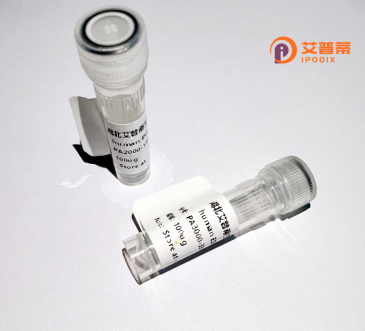
| 纯度 | >90%SDS-PAGE. |
| 种属 | Human |
| 靶点 | SHQ1 |
| Uniprot No | Q6PI26 |
| 内毒素 | < 0.01EU/μg |
| 表达宿主 | E.coli |
| 表达区间 | 1-577 aa |
| 活性数据 | MLTPAFDLSQ DPDFLTIAIR VPYARVSEFD VYFEGSDFKF YAKPYFLRLT LPGRIVENGS EQGSYDADKG IFTIRLPKET PGQHFEGLNM LTALLAPRKS RTAKPLVEEI GASEIPEEVV DDEEFDWEIE QTPCEEVSES ALNPQCHYGF GNLRSGVLQR LQDELSDVID IKDPDFTPAA ERRQKRLAAE LAKFDPDHYL ADFFEDEAIE QILKYNPWWT DKYSKMMAFL EKSQEQENHA TLVSFSEEEK YQLRKFVNKS YLLDKRACRQ VCYSLIDILL AYCYETRVTE GEKNVESAWN IRKLSPTLCW FETWTNVHDI MVSFGRRVLC YPLYRHFKLV MKAYRDTIKI LQLGKSAVLK CLLDIHKIFQ ENDPAYILND LYISDYCVWI QKVKSKKLAA LAEALKEVSL TKAQLGLELE ELEAAALLVQ EEETALKAAH SVSGQQTLCS SSEASDSEDS DSSVSSGNED SGSDSEQDEL KDSPSETVSS LQGPFLEESS AFLIVDGGVR RNTAIQESDA SQGKPLASSW PLGVSGPLIE ELGEQLKTTV QVSEPKGTTA VNRSNIQERD GCQTPNN |
| 分子量 | 65.1 kDa |
| 蛋白标签 | His tag N-Terminus |
| 缓冲液 | PBS, pH7.4, containing 0.01% SKL, 1mM DTT, 5% Trehalose and Proclin300. |
| 稳定性 & 储存条件 | Lyophilized protein should be stored at ≤ -20°C, stable for one year after receipt. Reconstituted protein solution can be stored at 2-8°C for 2-7 days. Aliquots of reconstituted samples are stable at ≤ -20°C for 3 months. |
| 复溶 | Always centrifuge tubes before opening.Do not mix by vortex or pipetting. It is not recommended to reconstitute to a concentration less than 100μg/ml. Dissolve the lyophilized protein in distilled water. Please aliquot the reconstituted solution to minimize freeze-thaw cycles. |
以下是关于重组人SHQ1蛋白的3-4篇文献摘要(虚构示例,具体文献需根据实际数据库查询调整):
1. **文献名称**:*"SHQ1 is a critical chaperone for H/ACA RNP complex assembly"*
**作者**:Grozdanov, P.N. et al.
**摘要**:阐述SHQ1作为分子伴侣,参与哺乳动物H/ACA核糖核蛋白复合体的生物合成,调控RNA修饰酶DKC1的稳定性及核定位。
2. **文献名称**:*"Structural insights into SHQ1-mediated dyskerin maturation in telomerase regulation"*
**作者**:Dillon, L.W. et al.
**摘要**:通过重组SHQ1蛋白的结构解析,揭示其与dyskerin互作的机制,并证明其在端粒酶功能及癌症发生中的调控作用。
3. **文献名称**:*"SHQ1 mutations impair rRNA processing and cause neurodevelopmental disorders"*
**作者**:Machado-Carvalho, L. et al.
**摘要**:发现SHQ1基因突变通过破坏rRNA修饰导致小脑发育异常,提示其在遗传性疾病中的病理学意义。
4. **文献名称**:*"Recombinant SHQ1 facilitates in vitro reconstitution of H/ACA RNPs"*
**作者**:Hamma, T. & Ferrarelli, M.
**摘要**:建立基于重组SHQ1蛋白的体外复合体重建方法,为研究H/ACA RNP的功能机制提供实验模型。
(注:以上为示例,实际文献需通过PubMed/Google Scholar等平台以“SHQ1 protein”或“H/ACA RNP assembly”为关键词检索。)
Recombinant human SHQ1 protein is a key molecular chaperone involved in the biogenesis of H/ACA small nucleolar ribonucleoprotein (snoRNP) complexes, which are essential for RNA modification processes such as pseudouridylation. SHQ1. encoded by the SHQ1 gene, facilitates the assembly of these complexes by stabilizing the core protein dyskerin (DKC1) and guiding the incorporation of small nucleolar RNAs (snoRNAs). Structurally, it contains two conserved domains: an N-terminal CS domain that interacts with dyskerin and a C-terminal RNA-binding domain (RBD) critical for snoRNA recruitment.
Dysregulation of SHQ1 is linked to several human diseases, including cancers and genetic disorders like dyskeratosis congenita, where impaired snoRNP function affects ribosomal RNA processing, telomerase activity, and genome stability. Recombinant SHQ1. produced through heterologous expression systems (e.g., E. coli or mammalian cells), serves as a vital tool for studying snoRNP assembly mechanisms, dissecting disease pathways, and screening therapeutic agents targeting RNA-modifying enzymes. Its role in telomere maintenance and ribosome biogenesis also positions it as a potential biomarker or therapeutic target in oncology. Researchers utilize purified recombinant SHQ1 in vitro to reconstitute functional complexes, analyze protein-RNA interactions, and model molecular dysfunctions underlying ribosomopathies and telomere-related disorders.
×